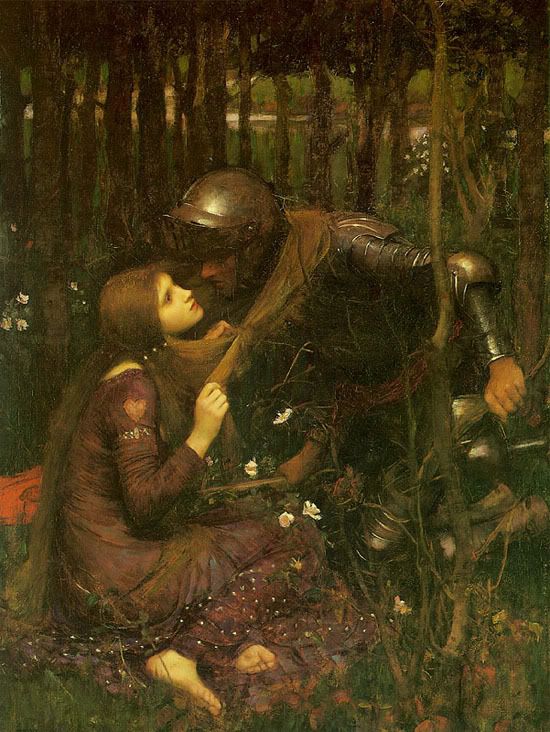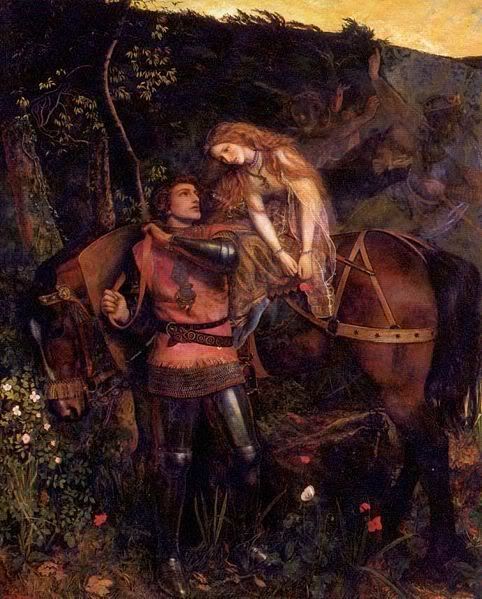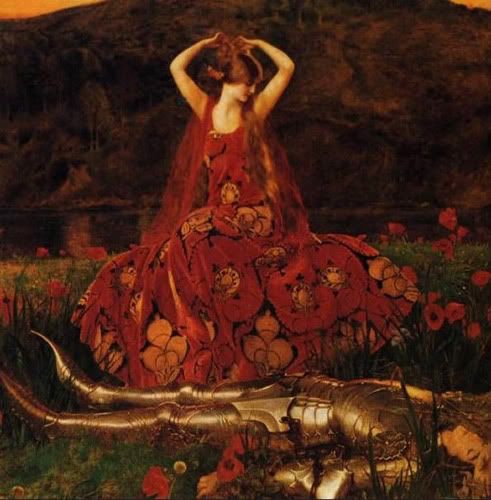Of all John Keat's poems, La Belle Dame sans Merci had by far the most influence on the Pre-Raphaelites. The symbolism and sadness in the poem, combined with its femme fatale leading lady must have made it difficult for them to resist! It has inspired numerous paintings. The most popular versions are probably those by John William Waterhouse, Arthur Hughes, and also later versions by Frank Cadogan Cooper and Sir Francis Bernard Dicksee. Walter Crane and Henry Maynell Rheam also did works inspired by the poem.
The poem describes an encounter between a knight and a mysterious lady. The story opens with a description of the knight "palely loitering" among the hillsides. He has had the misfortune to encounter a lovely woman with wild eyes, whose managed to convince him that she desperately needed his help, when in fact, she was merely plotting to ensnare him. As the knight lies sleeping in her lair, he dreams of the other "pale kings and warriors" that had been lured to her resting place. They warn that "La Belle Dame sans Merci hath thee in thrall!" When he wakes, he's wandering in the countryside. The moral of the story? Don't talk to strangers! Especially when they are lovely damsels in distress!
John William Waterhouse was inspired by Keat's poem and unveiled this painting in 1893. He certainly captures how convincing the lady is--she doesn't look like she could harm a fly. The knight is completely drawn in.
Arthur Hughes' knight looks quite taken with the lady. He doesn't seem to notice the ghosts of other lost souls trying to warn him away!
Sir Frank Dicksee painted his rendition in 1903. This painting is quite popular these days! I seem to see it in every calendar featuring knights, ladies and the like. I do love the mystical femme fatale quality that Dicksee has captured. The knight is certainly transfixed.
Frank Cagadon Cowper's version (1926) of La Belle Dame is strikingly modern in comparison to the other paintings. Look at the lovely textile designs on her dress! Interestingly, his knight is perhaps the most historically accurate.
Finally, on a lighter note, here's a 1920 Punch cartoon featuring the knight and lady. She's clearly more interested in her reflection in the knights armour than she is in seducing him. Hmm.
Monday, April 7, 2008
La Belle Dame sans Merci
Posted by
Margaret
at
8:07 AM
![]()
![]()
Labels: poetry, pre-raphaelites, waterhouse
Subscribe to:
Post Comments (Atom)


6 comments:
Love the Waterhouse and Dicksee takes on the theme--PRB at among their most splendid. And the poem...pure romance *SIGH* Sorry to be so slow stopping by here and with emails, we've had some computer issues since back from our trip--finally online again! Happy week, my friend ((HUGS))
We have the Waterhouse and the Dicksee paintings hanging up in Andrew's office. I esp. like the Dicksee one... our copy of it is quite large and took a lot of money to frame ;o) So beautiful...
I just love Waterhouse. Love love love him.
I have a whole theory about the original poem, and wrote several papers on it in college. The best poems are the ones that inspire thought and creative work both! And this is most certainly one of those poems :)
These are beautiful Margaret. I used to have a print of the Dicksee La Belle. It was lovely.
Nancy
We are reading Eve of St. Agnes in a Lit. Studies class and my curiosity of the reference to "La Belle Dame Sans Merci" brought me to your page. I thought it was a lovely, concise compilation of artwork. Such beautiful works! I will be sure to share your page with my classmates. I wanted to leave you a note of encouragement and to show my appreciation.
Thanks!
AD
Post a Comment